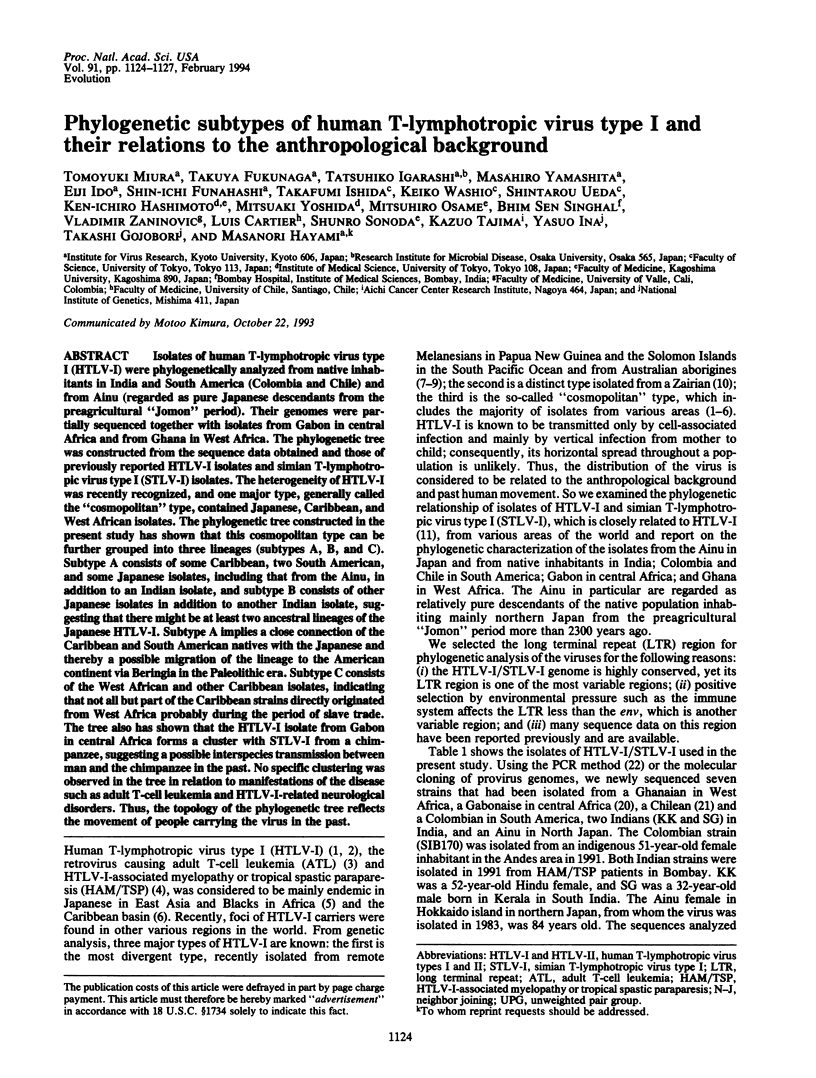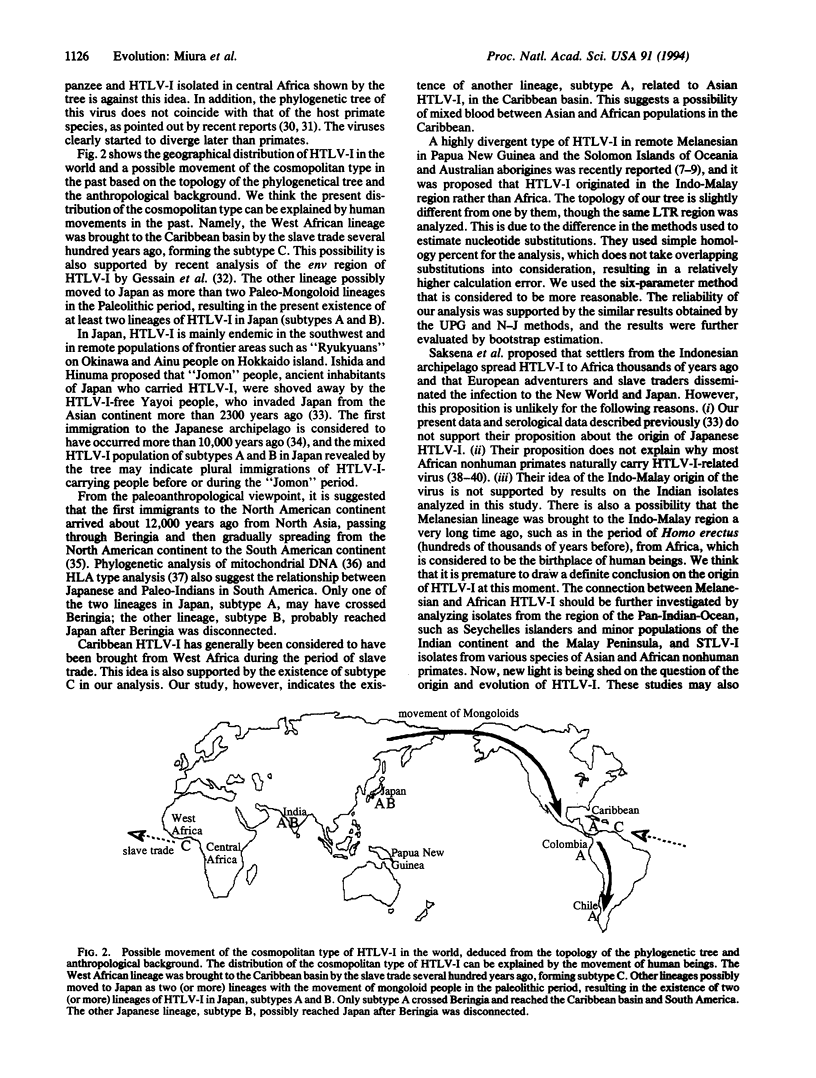Abstract
Isolates of human T-lymphotropic virus type I (HTLV-I) were phylogenetically analyzed from native inhabitants in India and South America (Colombia and Chile) and from Ainu (regarded as pure Japanese descendants from the preagricultural "Jomon" period). Their genomes were partially sequenced together with isolates from Gabon in central Africa and from Ghana in West Africa. The phylogenetic tree was constructed from the sequence data obtained and those of previously reported HTLV-I isolates and simian T-lymphotropic virus type I (STLV-I) isolates. The heterogeneity of HTLV-I was recently recognized, and one major type, generally called the "cosmopolitan" type, contained Japanese, Caribbean, and West African isolates. The phylogenetic tree constructed in the present study has shown that this cosmopolitan type can be further grouped into three lineages (subtypes A, B, and C). Subtype A consists of some Caribbean, two South American, and some Japanese isolates, including that from the Ainu, in addition to an Indian isolate, and subtype B consists of other Japanese isolates in addition to another Indian isolate, suggesting that there might be at least two ancestral lineages of the Japanese HTLV-I. Subtype A implies a close connection of the Caribbean and South American natives with the Japanese and thereby a possible migration of the lineage to the American continent via Beringia in the Paleolithic era. Subtype C consists of the West African and other Caribbean isolates, indicating that not all but part of the Caribbean strains directly originated from West Africa probably during the period of slave trade. The tree also has shown that the HTLV-I isolate from Gabon in central Africa forms a cluster with STLV-I from a chimpanzee, suggesting a possible interspecies transmission between man and the chimpanzee in the past. No specific clustering was observed in the tree in relation to manifestations of the disease such as adult T-cell leukemia and HTLV-I-related neurological disorders. Thus, the topology of the phylogenetic tree reflects the movement of people carrying the virus in the past.
Full text
PDF



Selected References
These references are in PubMed. This may not be the complete list of references from this article.
- Bastian I., Gardner J., Webb D., Gardner I. Isolation of a human T-lymphotropic virus type I strain from Australian aboriginals. J Virol. 1993 Feb;67(2):843–851. doi: 10.1128/jvi.67.2.843-851.1993. [DOI] [PMC free article] [PubMed] [Google Scholar]
- Biggar R. J., Saxinger C., Gardiner C., Collins W. E., Levine P. H., Clark J. W., Nkrumah F. K., Blattner W. A. Type-I HTLV antibody in urban and rural Ghana, West Africa. Int J Cancer. 1984 Aug 15;34(2):215–219. doi: 10.1002/ijc.2910340212. [DOI] [PubMed] [Google Scholar]
- Blattner W. A., Kalyanaraman V. S., Robert-Guroff M., Lister T. A., Galton D. A., Sarin P. S., Crawford M. H., Catovsky D., Greaves M., Gallo R. C. The human type-C retrovirus, HTLV, in Blacks from the Caribbean region, and relationship to adult T-cell leukemia/lymphoma. Int J Cancer. 1982 Sep 15;30(3):257–264. doi: 10.1002/ijc.2910300302. [DOI] [PubMed] [Google Scholar]
- Cartier L., Araya F., Castillo J. L., Zaninovic V., Hayami M., Miura T., Imai J., Sonoda S., Shiraki H., Miyamoto K. Southernmost carriers of HTLV-I/II in the world. Jpn J Cancer Res. 1993 Jan;84(1):1–3. doi: 10.1111/j.1349-7006.1993.tb02774.x. [DOI] [PMC free article] [PubMed] [Google Scholar]
- Evangelista A., Maroushek S., Minnigan H., Larson A., Retzel E., Haase A., Gonzalez-Dunia D., McFarlin D., Mingioli E., Jacobson S. Nucleotide sequence analysis of a provirus derived from an individual with tropical spastic paraparesis. Microb Pathog. 1990 Apr;8(4):259–278. doi: 10.1016/0882-4010(90)90052-r. [DOI] [PubMed] [Google Scholar]
- Fukasawa M., Tsujimoto H., Ishikawa K., Miura T., Ivanoff B., Cooper R. W., Frost E., Delaporte E., Mingle J. A., Grant F. C. Human T-cell leukemia virus type I isolates from Gabon and Ghana: comparative analysis of proviral genomes. Virology. 1987 Dec;161(2):315–320. doi: 10.1016/0042-6822(87)90123-1. [DOI] [PubMed] [Google Scholar]
- Gessain A., Boeri E., Yanagihara R., Gallo R. C., Franchini G. Complete nucleotide sequence of a highly divergent human T-cell leukemia (lymphotropic) virus type I (HTLV-I) variant from melanesia: genetic and phylogenetic relationship to HTLV-I strains from other geographical regions. J Virol. 1993 Feb;67(2):1015–1023. doi: 10.1128/jvi.67.2.1015-1023.1993. [DOI] [PMC free article] [PubMed] [Google Scholar]
- Gessain A., Gallo R. C., Franchini G. Low degree of human T-cell leukemia/lymphoma virus type I genetic drift in vivo as a means of monitoring viral transmission and movement of ancient human populations. J Virol. 1992 Apr;66(4):2288–2295. doi: 10.1128/jvi.66.4.2288-2295.1992. [DOI] [PMC free article] [PubMed] [Google Scholar]
- Gojobori T., Ishii K., Nei M. Estimation of average number of nucleotide substitutions when the rate of substitution varies with nucleotide. J Mol Evol. 1982;18(6):414–423. doi: 10.1007/BF01840889. [DOI] [PubMed] [Google Scholar]
- Hashimoto K., Lalkaka J., Fujisawa J., Singhal B. S., Machigashira K., Kubota R., Suehara M., Osame M., Yoshida M. Limited sequence divergence of HTLV-I of Indian HAM/TSP patients from a prototype Japanese isolate. AIDS Res Hum Retroviruses. 1993 Jun;9(6):495–498. doi: 10.1089/aid.1993.9.495. [DOI] [PubMed] [Google Scholar]
- Hayami M., Komuro A., Nozawa K., Shotake T., Ishikawa K., Yamamoto K., Ishida T., Honjo S., Hinuma Y. Prevalence of antibody to adult T-cell leukemia virus-associated antigens (ATLA) in Japanese monkeys and other non-human primates. Int J Cancer. 1984 Feb 15;33(2):179–183. doi: 10.1002/ijc.2910330205. [DOI] [PubMed] [Google Scholar]
- Hinuma Y., Nagata K., Hanaoka M., Nakai M., Matsumoto T., Kinoshita K. I., Shirakawa S., Miyoshi I. Adult T-cell leukemia: antigen in an ATL cell line and detection of antibodies to the antigen in human sera. Proc Natl Acad Sci U S A. 1981 Oct;78(10):6476–6480. doi: 10.1073/pnas.78.10.6476. [DOI] [PMC free article] [PubMed] [Google Scholar]
- Horai S., Kondo R., Murayama K., Hayashi S., Koike H., Nakai N. Phylogenetic affiliation of ancient and contemporary humans inferred from mitochondrial DNA. Philos Trans R Soc Lond B Biol Sci. 1991 Sep 30;333(1268):409–417. doi: 10.1098/rstb.1991.0091. [DOI] [PubMed] [Google Scholar]
- Ina Y., Gojobori T. Molecular evolution of human T-cell leukemia virus. J Mol Evol. 1990 Dec;31(6):493–499. doi: 10.1007/BF02102076. [DOI] [PubMed] [Google Scholar]
- Ishida T., Hinuma Y. The origin of Japanese HTLV-I. Nature. 1986 Aug 7;322(6079):504–504. doi: 10.1038/322504a0. [DOI] [PubMed] [Google Scholar]
- Ishikawa K., Fukasawa M., Tsujimoto H., Else J. G., Isahakia M., Ubhi N. K., Ishida T., Takenaka O., Kawamoto Y., Shotake T. Serological survey and virus isolation of simian T-cell leukemia/T-lymphotropic virus type I (STLV-I) in non-human primates in their native countries. Int J Cancer. 1987 Aug 15;40(2):233–239. doi: 10.1002/ijc.2910400219. [DOI] [PubMed] [Google Scholar]
- Josephs S. F., Wong-Staal F., Manzari V., Gallo R. C., Sodroski J. G., Trus M. D., Perkins D., Patarca R., Haseltine W. A. Long terminal repeat structure of an American isolate of type I human T-cell leukemia virus. Virology. 1984 Dec;139(2):340–345. doi: 10.1016/0042-6822(84)90379-9. [DOI] [PubMed] [Google Scholar]
- Komurian F., Pelloquin F., de Thé G. In vivo genomic variability of human T-cell leukemia virus type I depends more upon geography than upon pathologies. J Virol. 1991 Jul;65(7):3770–3778. doi: 10.1128/jvi.65.7.3770-3778.1991. [DOI] [PMC free article] [PubMed] [Google Scholar]
- Komuro A., Watanabe T., Miyoshi I., Hayami M., Tsujimoto H., Seiki M., Yoshida M. Detection and characterization of simian retroviruses homologous to human T-cell leukemia virus type I. Virology. 1984 Oct 30;138(2):373–378. doi: 10.1016/0042-6822(84)90364-7. [DOI] [PubMed] [Google Scholar]
- Malik K. T., Even J., Karpas A. Molecular cloning and complete nucleotide sequence of an adult T cell leukaemia virus/human T cell leukaemia virus type I (ATLV/HTLV-I) isolate of Caribbean origin: relationship to other members of the ATLV/HTLV-I subgroup. J Gen Virol. 1988 Jul;69(Pt 7):1695–1710. doi: 10.1099/0022-1317-69-7-1695. [DOI] [PubMed] [Google Scholar]
- Osame M., Usuku K., Izumo S., Ijichi N., Amitani H., Igata A., Matsumoto M., Tara M. HTLV-I associated myelopathy, a new clinical entity. Lancet. 1986 May 3;1(8488):1031–1032. doi: 10.1016/s0140-6736(86)91298-5. [DOI] [PubMed] [Google Scholar]
- Poiesz B. J., Ruscetti F. W., Gazdar A. F., Bunn P. A., Minna J. D., Gallo R. C. Detection and isolation of type C retrovirus particles from fresh and cultured lymphocytes of a patient with cutaneous T-cell lymphoma. Proc Natl Acad Sci U S A. 1980 Dec;77(12):7415–7419. doi: 10.1073/pnas.77.12.7415. [DOI] [PMC free article] [PubMed] [Google Scholar]
- Ratner L., Philpott T., Trowbridge D. B. Nucleotide sequence analysis of isolates of human T-lymphotropic virus type 1 of diverse geographical origins. AIDS Res Hum Retroviruses. 1991 Nov;7(11):923–941. doi: 10.1089/aid.1991.7.923. [DOI] [PubMed] [Google Scholar]
- Saiki R. K., Gelfand D. H., Stoffel S., Scharf S. J., Higuchi R., Horn G. T., Mullis K. B., Erlich H. A. Primer-directed enzymatic amplification of DNA with a thermostable DNA polymerase. Science. 1988 Jan 29;239(4839):487–491. doi: 10.1126/science.2448875. [DOI] [PubMed] [Google Scholar]
- Saitou N., Nei M. The neighbor-joining method: a new method for reconstructing phylogenetic trees. Mol Biol Evol. 1987 Jul;4(4):406–425. doi: 10.1093/oxfordjournals.molbev.a040454. [DOI] [PubMed] [Google Scholar]
- Saksena N. K., Hervé V., Sherman M. P., Durand J. P., Mathiot C., Müller M., Love J. L., LeGuenno B., Sinoussi F. B., Dube D. K. Sequence and phylogenetic analyses of a new STLV-I from a naturally infected tantalus monkey from Central Africa. Virology. 1993 Jan;192(1):312–320. doi: 10.1006/viro.1993.1035. [DOI] [PubMed] [Google Scholar]
- Saksena N. K., Sherman M. P., Yanagihara R., Dube D. K., Poiesz B. J. LTR sequence and phylogenetic analyses of a newly discovered variant of HTLV-I isolated from the Hagahai of Papua New Guinea. Virology. 1992 Jul;189(1):1–9. doi: 10.1016/0042-6822(92)90675-f. [DOI] [PubMed] [Google Scholar]
- Seiki M., Hattori S., Hirayama Y., Yoshida M. Human adult T-cell leukemia virus: complete nucleotide sequence of the provirus genome integrated in leukemia cell DNA. Proc Natl Acad Sci U S A. 1983 Jun;80(12):3618–3622. doi: 10.1073/pnas.80.12.3618. [DOI] [PMC free article] [PubMed] [Google Scholar]
- Seiki M., Hattori S., Yoshida M. Human adult T-cell leukemia virus: molecular cloning of the provirus DNA and the unique terminal structure. Proc Natl Acad Sci U S A. 1982 Nov;79(22):6899–6902. doi: 10.1073/pnas.79.22.6899. [DOI] [PMC free article] [PubMed] [Google Scholar]
- Shimotohno K., Takahashi Y., Shimizu N., Gojobori T., Golde D. W., Chen I. S., Miwa M., Sugimura T. Complete nucleotide sequence of an infectious clone of human T-cell leukemia virus type II: an open reading frame for the protease gene. Proc Natl Acad Sci U S A. 1985 May;82(10):3101–3105. doi: 10.1073/pnas.82.10.3101. [DOI] [PMC free article] [PubMed] [Google Scholar]
- Shirabe S., Nakamura T., Tsujihata M., Nagataki S., Seiki M., Yoshida M. Retrovirus from human T-cell leukemia virus type I-associated myelopathy is the same strain as a prototype human T-cell leukemia virus type I. Arch Neurol. 1990 Nov;47(11):1258–1260. doi: 10.1001/archneur.1990.00530110120029. [DOI] [PubMed] [Google Scholar]
- Tsujimoto A., Teruuchi T., Imamura J., Shimotohno K., Miyoshi I., Miwa M. Nucleotide sequence analysis of a provirus derived from HTLV-1-associated myelopathy (HAM). Mol Biol Med. 1988 Feb;5(1):29–42. [PubMed] [Google Scholar]
- Tsujimoto H., Komuro A., Iijima K., Miyamoto J., Ishikawa K., Hayami M. Isolation of simian retroviruses closely related to human T-cell leukemia virus by establishment of lymphoid cell lines from various non-human primates. Int J Cancer. 1985 Mar 15;35(3):377–384. doi: 10.1002/ijc.2910350314. [DOI] [PubMed] [Google Scholar]
- Uchiyama T., Yodoi J., Sagawa K., Takatsuki K., Uchino H. Adult T-cell leukemia: clinical and hematologic features of 16 cases. Blood. 1977 Sep;50(3):481–492. [PubMed] [Google Scholar]
- Watanabe T., Seiki M., Hirayama Y., Yoshida M. Human T-cell leukemia virus type I is a member of the African subtype of simian viruses (STLV). Virology. 1986 Jan 30;148(2):385–388. doi: 10.1016/0042-6822(86)90336-3. [DOI] [PubMed] [Google Scholar]


